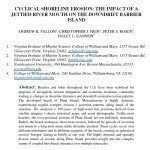First Nor’easter of 2014-15 Season
October 27, 2014 by Chris Hein
Williamsburg, VA
The storm that rolled through New England last week marked the first nor’easter of the 2014-15 storm season. Yea!(?)
Local reports indicate that damage was not terribly extensive. No major scarping in front of homes, certainly no homes lost. This is all great news. However, if you make it out to the beach in the next days, look for other ominous signs of its effects. The beach has spent the last six months building vertically (accreting) and widening (prograding). This produces a nice high, wide berm (where you park your beach blanket on a summer day) above high tide. This is called the “summer” beach profile.
A typical effect of the first storm of the year is to erode away the berm and flatten the overall beach, leaving a “winter” profile. Check out these images (from the Maine Department of Conservation) for a comparison of summer and winter beach profiles:
So what, this first nor’easter eroded away the beach berm and flattened the beach? It is a completely natural and expected process. Beaches are always coarser and flatter in the winter. Well, this summer profile is the first line of defense against wave attack. With this gone, it leaves the remaining beach and dunes more vulnerable to waves from the next storm. If there is a long enough period in between storms the beach can recover some of its “summer” profile and the next moderate storm will have a minimal impact. However, if the next one comes too soon while the natural defenses are still weak, then even a small to moderate storm can have severe impacts.
Of course, my thoughts here on the impacts of this first storm are somewhat speculative – based on newspaper reports, sparse photos, and my knowledge of coastal processes. I have not actually seen the impacts of the storm. One of the most challenging aspects of studying a barrier island in Massachusetts, while living in Virginia, is how hard it is to get to the site. I’ve done that 12-hour drive enough times in the last year (10 round trips maybe?) to know how painful traffic in and around DC, Baltimore, New York, New Haven and Boston can be!
As a field geologist, it is crucial to get out and walk the beach to truly understand how it is changing. Since that is not possible due to time and money constraints (and my teaching schedule here at VIMS . . . though I am sure my students would not be too upset if I missed a few days of class), I am relying on the observations of those who can get to the beach and see what has changed. Andy will be up on Plum Island in early November doing his monthly survey – certainly the impacts of this storm will be seen in those data. However, in the meantime, if you are reading this and have some pictures or observations you would like to share, please email me ([email protected]). I’ll be glad to post anything to the blog as well if you would like to share more broadly!
Here’s hoping that this is one of very few nor’easter blog posts I write this winter storm season!
– Chris


 June 14, 2015 - Rowley House, Rowley, MA One week down . . . one to go. Claudia, Justin, and I are at the half-way point of a major […]
June 14, 2015 - Rowley House, Rowley, MA One week down . . . one to go. Claudia, Justin, and I are at the half-way point of a major […] May 15, 2015 - Williamsburg, VA I am just back from beautiful, sunny San Diego! Andy Fallon and I were out there all of this past week at the […]
May 15, 2015 - Williamsburg, VA I am just back from beautiful, sunny San Diego! Andy Fallon and I were out there all of this past week at the […] Posted: May 15, 2015
Posted: May 15, 2015